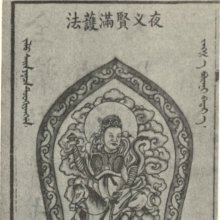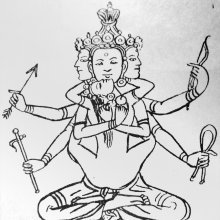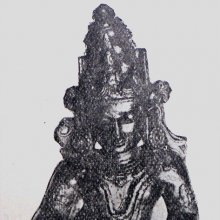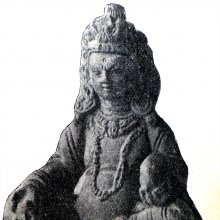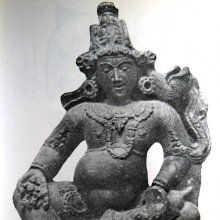Purnabhadra, Purna-bhadra, Pūrṇabhadra: 17 definitions
Introduction:
Purnabhadra means something in Buddhism, Pali, Hinduism, Sanskrit, Jainism, Prakrit. If you want to know the exact meaning, history, etymology or English translation of this term then check out the descriptions on this page. Add your comment or reference to a book if you want to contribute to this summary article.
Images (photo gallery)
In Hinduism
Purana and Itihasa (epic history)
Source: archive.org: Puranic Encyclopedia1) Pūrṇabhadra (पूर्णभद्र).—A celebrated serpent of the family of Kaśyapa. (Śloka 12, Chapter 35, Ādi Parva).
2) Pūrṇabhadra (पूर्णभद्र).—The son of a Yakṣa called Ratnabhadra living on the mountain Gandhamādana. He had a son named Harikeśa (Piṅgala). Harikeśa was a devotee of Śiva and so Pūrṇabhadra who was a devotee of Kubera sent Harikeśa away from his house. Harikeśa was then taken care of by Śiva and made one of his attendants. (Matsya Purāṇa, Chapter 18).
Source: archive.org: Shiva Purana - English TranslationPūrṇabhadra (पूर्णभद्र) is the name of a leader of Gaṇas (Gaṇapa or Gaṇeśvara or Gaṇādhipa) who came to Kailāsa, according to the Śivapurāṇa 2.1.20. Accordingly, after Śiva decided to become the friend of Kubera:—“[...] The leaders of Gaṇas revered by the whole world and of high fortune arrived there. [...] Nīla, Deveśa and Pūrṇabhadra each with ninety crores and the strong Caturvaktra with seven crores. [...]”.
These [viz., Pūrṇabhadra] and other leaders of Gaṇas [viz., Gaṇapas] were all powerful (mahābala) and innumerable (asaṃkhyāta). [...] The Gaṇa chiefs and other noble souls of spotless splendour eagerly reached there desirous of seeing Śiva. Reaching the spot they saw Śiva, bowed to and eulogised him.
Pūrṇabhadra participated in Vīrabhadra’s campaign against Dakṣa, according to the Śivapurāṇa 2.2.33. Accordingly, as Brahmā narrated to Nārada:—“O Nārada, listen to the numerical strength of the most important and courageous of those groups. [...] O dear, the chief of Gaṇas, Madhupiṅga was the leader of ninety crores. Pūrṇabhadra also started with as many attendants. [...] Thus at the bidding of Śiva, the heroic Vīrabhadra went ahead followed by crores and crores, thousands and thousands, hundreds and hundreds of Gaṇas [viz., Pūrṇabhadra]”.
Source: Cologne Digital Sanskrit Dictionaries: The Purana Index1a) Pūrṇabhadra (पूर्णभद्र).—The sage who blessed Campa with a son, Haryanga.*
- * Matsya-purāṇa 48. 98; Vāyu-purāṇa 99. 107.
1b) The Yakṣa whose son was Harikeśa and who was a devotee of Śiva from boyhood, and who hated the cruel habits of the Yakṣas; hence banished the son who went to Benares for penance.*
- * Matsya-purāṇa 180. 5-14.
1c) A son of Maṇivara.*
- * Vāyu-purāṇa 69. 158.
1d) A class of Yakṣas.*
- * Brahmāṇḍa-purāṇa III. 7. 162; IV. 33. 78.
Pūrṇabhadra is the name of a Serpent (sarpa) mentioned in the thirty-fifth chapter (verses 4-17) of the Ādiparva of the Mahābhārata.—Accordingly, Sauti, on being implored by Śaunaka to name all the serpents in the course of the sarpa-sattra, tells him that it is humanly impossible to give a complete list because of their sheer multiplicity; but would name the prominent ones in accordance with their significance [e.g., Pūrṇabhadra].

The Purana (पुराण, purāṇas) refers to Sanskrit literature preserving ancient India’s vast cultural history, including historical legends, religious ceremonies, various arts and sciences. The eighteen mahapuranas total over 400,000 shlokas (metrical couplets) and date to at least several centuries BCE.
In Buddhism
Tibetan Buddhism (Vajrayana or tantric Buddhism)
Source: Wisdom Library: Tibetan BuddhismPūrṇabhadra (पूर्णभद्र) is the name of a deity summoned by the Yamāntaka-mantra and mentioned as attending the teachings in the 6th century Mañjuśrīmūlakalpa: one of the largest Kriyā Tantras devoted to Mañjuśrī (the Bodhisattva of wisdom) representing an encyclopedia of knowledge primarily concerned with ritualistic elements in Buddhism. The teachings in this text originate from Mañjuśrī and were taught to and by Buddha Śākyamuni in the presence of a large audience (including Pūrṇabhadra).
Source: archive.org: The Indian Buddhist Iconography1) Pūrṇabhadra (पूर्णभद्र) and Dattā refers to one of the eight Yakṣa and Śakti pair occupying the double lotus in the sādhana of Jambhala (yab-yum form), as described in the 5th-century Sādhanamālā (a collection of sādhana texts that contain detailed instructions for rituals).—Accordingly, when represented in Yab-Yum, he sits on the moon under which there is a double lotus of eight petals. [...] The eight petals of the lotus seat are occupied by the eight Yakṣas [viz., Pūrṇabhadra], who are identical in all respects with the principal figure. Each Yakṣa is accompanied by a Śakti [viz., Dattā] with whom he remains in Yab-Yum in the same way as Jambhala remains with Vasudhārā [...]. The Yakṣiṇīs are identical in form with Vasudhārā, who is yellow in complexion, carries the ears of corn and shows the Varada-mudrā in her two hands.]
2) Pūrṇabhadra (पूर्णभद्र) refers to eight Yakṣa kings, commonly depicted in Buddhist Iconography, and mentioned in the 11th-century Niṣpannayogāvalī of Mahāpaṇḍita Abhayākara.—The Yakṣas are a semi-mythical class of beings who are supposed to preside over treasures and shower wealth on mankind when propitiated. They are all collectively described in the dharmadhātuvāgīśvara-maṇḍala in one brief sentence:—“The Yakṣa kings [viz., Pūrṇabhadra] hold in their hands the bījapūra (citron) and the nakula (mongoose) in the right and left hands respectively”.—Pūrṇabhadra is blue in colour.
Source: OSU Press: Cakrasamvara SamadhiPūrṇabhadra (पूर्णभद्र) is the name of a deity [i.e., oṃ pūrṇabhadrāya svāhā], according to the Kalaśa Pūjā [i.e., Kalasha Worship] ritual often performed in combination with the Cakrasaṃvara Samādhi, which refers to the primary pūjā and sādhanā practice of Newah Mahāyāna-Vajrayāna Buddhists in Nepal.

Tibetan Buddhism includes schools such as Nyingma, Kadampa, Kagyu and Gelug. Their primary canon of literature is divided in two broad categories: The Kangyur, which consists of Buddha’s words, and the Tengyur, which includes commentaries from various sources. Esotericism and tantra techniques (vajrayāna) are collected indepently.
Mahayana (major branch of Buddhism)
Source: archive.org: Bulletin of the French School of the Far East (volume 5)Pūrṇabhadra (पूर्णभद्र) is the name of a Yakṣa appointed as one of the Divine protector deities of Tivani, according to chapter 17 of the Candragarbha: the 55th section of the Mahāsaṃnipāta-sūtra, a large compilation of Sūtras (texts) in Mahāyāna Buddhism partly available in Sanskrit, Tibetan and Chinese.—In the Candragarbhasūtra, the Bhagavat invites all classes of Gods and Deities to protect the Law [dharma?] and the faithful in their respective kingdoms of Jambudvīpa [e.g., the Yakṣa Pūrṇabhadra in Tivani], resembling the time of the past Buddhas.

Mahayana (महायान, mahāyāna) is a major branch of Buddhism focusing on the path of a Bodhisattva (spiritual aspirants/ enlightened beings). Extant literature is vast and primarely composed in the Sanskrit language. There are many sūtras of which some of the earliest are the various Prajñāpāramitā sūtras.
In Jainism
General definition (in Jainism)
Source: Wisdom Library: Jainism1) Pūrṇabhadra (पूर्णभद्र) is the Sanskrit rendering of Puṇṇabhadda, a Yakṣa chief obiedient to Vaiśramaṇa (god of wealth, also known as Kubera), Bhagavatī-sūtra, also known as The Vyākhyāprajñapti (“Exposition of Explanations”). The Bhagavatī-sūtra is the largest of twelve Jain āgamas and was composed by Sudharmāsvāmī in the 6th century.
2) Pūrṇabhadra (पूर्णभद्र) is the name of a Yakṣa mentioned in the Tattvārtha-bhāṣya amongst a list of thirteen. The Tattvārtha-bhāṣya is a commentary on the Tattvārtha-sūtra, an ancient and foundational Jain text written in the 2nd century by Umāsvāti. It contains philosophy accepted as authoritative by both the Digambara and the Śvetāmbara sects of Jainism.
3) Pūrṇabhadra (पूर्णभद्र) refers to a class of yakṣa deities according to both the Śvetāmbara and the Digambara traditions. The yakṣas refer to a category of vyantaras gods which represents one of the four classes of celestial beings (devas). The assigned color of yakṣas is black and their caitya-vṛkṣa (sacred tree) is the “banyan tree” (vaṭa).
The deities such as the Pūrṇabhadras are defined in ancient Jain cosmological texts such as the Saṃgrahaṇīratna in the Śvetāmbara tradition or the Tiloyapaṇṇati by Yativṛṣabha (5th century) in the Digambara tradition.
4) Pūrṇabhadra (पूर्णभद्र) is the name of a caitya (‘shrine’, dedicated to a deity), located in the town Campā (near Bhagalpur), according to the Bhagavatī-sūtra, also known as The Vyākhyāprajñapti (“Exposition of Explanations”). The Bhagavatī-sūtra is the largest of twelve Jain āgamas and was composed by Sudharmāsvāmī in the 6th century.
5) Pūrṇabhadra (पूर्णभद्र).—One of the nine peaks (kūṭa) of the Vaitāḍhya mountains, which is situated in the center of Bhārata (parallel to the Himavān). The name dakṣiṇārdhabharata is derived from the similarly named deity presiding over it. Bhārata is one of the seven regions (kṣetra) of Jambūdvīpa according to Jaina cosmology. Jambūdvīpa sits at the centre of madhyaloka (‘middle world’) is the most important of all continents and it is here where human beings reside.
Source: archive.org: The Jaina IconographyPūrṇabhadra (पूर्णभद्र) refers to one of the various attendants of Kubera (king of the Yakṣas).—Kubera was the treasurer of Śiva and lord of the Alakā is several times referred to in early Hindu literature. His attendants were many and several of them are mentioned in a canonical text of the Jainas thus, [viz., Pūrṇabhadra].
Source: archive.org: Trisastisalakapurusacaritra1) Pūrṇabhadra (पूर्णभद्र) is the son of Sāgaradatta and friend of Jīvānanda (a previous incarnation of Ṛṣabha), according to chapter 1.1 [ādīśvara-caritra] of Hemacandra’s 11th century Triṣaṣṭiśalākāpuruṣacaritra: an ancient Sanskrit epic poem narrating the history and legends of sixty-three illustrious persons in Jainism.
Accordingly,
“After he had enjoyed pleasures unceasingly, the soul of Vajrajaṅgha fell from the exhaustion of his life-span, just as a snow-ball melts in the sun. In Jambūdvīpa, in the Videhas, in the city Kṣitipratiṣṭhita, he was born as the son, named Jīvānanda, of the physician Suvidhi. [...] At the same time in this city four other boys were born, like pieces of dharma joined to bodies. [...] Another was the son, named Pūrṇabhadra, of the trader Sāgaradatta and his wife Abhayavatī”.
2) Pūrṇabhadra (पूर्णभद्र) also refers to a merchant from Aparājitā, according to chapter 1.2.—Accordingly, “[...] Sāgara saw there Priyadarśanā, the daughter of the merchant Pūrṇabhadra, who had been seized by bandits like a black doe by wolves. The merchant’s son crushed the hand of one bandit and took away his knife, just as one would take a jewel after breaking a serpent’s neck. [...]”.
3) Pūrṇabhadra (पूर्णभद्र) and Māṇibhadra are the two Indras (i.e., lords or kings) of the Yakṣas who came to the peak of Meru for partaking in the birth-ceremonies of Ṛṣabha, according to chapter 1.2.
Source: HereNow4u: Lord Śrī MahāvīraPūrṇabhadra (पूर्णभद्र) is the name of a sacred spot visited by Mahāvīra during his 5th Year as Kevalī.—Completing the monsoon period in Rājagṛha, the Lord went to Campā and stayed at Pūrṇabhadra there. Hearing news of his arrival there, the king of the city, Datta, came with his family.
Pūrṇabhadra was also visited by Mahāvīra during his 13th, 14th and 18th year as Kevalī.
Source: Encyclopedia of Jainism: Tattvartha Sutra 4: The celestial beings (deva)Pūrṇabhadra (पूर्णभद्र) refers to one of the two Indras (lords) of the Yakṣa class of “peripatetic celestial beings” (vyantara), itself a main division of devas (celestial beings) according to the 2nd-century Tattvārthasūtra 4.6. Pūrṇabhadra and Maṇibhadra are the two lords in the class ‘treasure-keeper’ peripatetic celestial beings.

Jainism is an Indian religion of Dharma whose doctrine revolves around harmlessness (ahimsa) towards every living being. The two major branches (Digambara and Svetambara) of Jainism stimulate self-control (or, shramana, ‘self-reliance’) and spiritual development through a path of peace for the soul to progess to the ultimate goal.
Languages of India and abroad
Sanskrit dictionary
Source: Cologne Digital Sanskrit Dictionaries: Edgerton Buddhist Hybrid Sanskrit DictionaryPūrṇabhadra (पूर्णभद्र).—name of a future Buddha which it is predicted that Pūrṇa (1) will become: Avadāna-śataka i.7.4.
Source: Cologne Digital Sanskrit Dictionaries: Aufrecht Catalogus CatalogorumPūrṇabhadra (पूर्णभद्र) as mentioned in Aufrecht’s Catalogus Catalogorum:—revised by desire of Somamantrin the Pañcatantra in 1514. Io. 2643.
Source: Cologne Digital Sanskrit Dictionaries: Monier-Williams Sanskrit-English Dictionary1) Pūrṇabhadra (पूर्णभद्र):—[=pūrṇa-bhadra] [from pūrṇa > pūra] m. Name of a serpent-demon, [Mahābhārata]
2) [v.s. ...] of the father of the Yakṣa Hari-keśa, [Skanda-purāṇa]
3) [v.s. ...] of several men, [Harivaṃśa; Daśakumāra-carita]
4) [v.s. ...] of a scholar (who revised the Pañcatantra in 1514), [Catalogue(s)]
[Sanskrit to German]
Sanskrit, also spelled संस्कृतम् (saṃskṛtam), is an ancient language of India commonly seen as the grandmother of the Indo-European language family (even English!). Closely allied with Prakrit and Pali, Sanskrit is more exhaustive in both grammar and terms and has the most extensive collection of literature in the world, greatly surpassing its sister-languages Greek and Latin.
See also (Relevant definitions)
Partial matches: Purna, Bhadra.
Full-text (+13): Yaksha, Puṇṇabhadda, Manibhadra, Lohitaksha, Vaishravana, Yakshadeva, Datta, Saptakoti, Navatikoti, Vimshakoti, Romaka, Campa, Ahiromaka, Kumbha, Vimsha, Sumantra, Navati, Abhayavati, Tivani, Priyadarshana.
Relevant text
Search found 21 books and stories containing Purnabhadra, Pūrṇa-bhadra, Purna-bhadra, Pūrṇabhadra; (plurals include: Purnabhadras, bhadras, Pūrṇabhadras). You can also click to the full overview containing English textual excerpts. Below are direct links for the most relevant articles:
Mahabharata (English) (by Kisari Mohan Ganguli)
Section XXXV < [Astika Parva]
The Matsya Purana (critical study) (by Kushal Kalita)
Part 2.1l - The Anva Dynasty < [Chapter 3 - Historical aspects in the Matsyapurāṇa]
Part 4 - Contents of the Matsyapurāṇa (summary) < [Chapter 1 - Introduction]
Trishashti Shalaka Purusha Caritra (by Helen M. Johnson)
Part 11: Origin of Dhūmaketu’s enmity < [Chapter VI - Marriage of Kṛṣṇa with Rukmiṇī and others]
Part 19: The Vyantaras < [Chapter III - The initiation and omniscience of Ajita]
Part 7: Story of Kāmadeva < [Chapter VIII - Initiation of ṛṣabhadatta and devānandā]
Tattvartha Sutra (with commentary) (by Vijay K. Jain)
Verse 4.6 - The two lords (indra) < [Chapter 4 - The Celestial Beings]
Animal Kingdom (Tiryak) in Epics (by Saranya P.S)
The Skanda Purana (by G. V. Tagare)
Chapter 32 - The Manifestation of Daṇḍapāṇi < [Section 1 - Pūrvārdha]
Chapter 5 - Agastya’s Departure < [Section 1 - Pūrvārdha]
Related products
